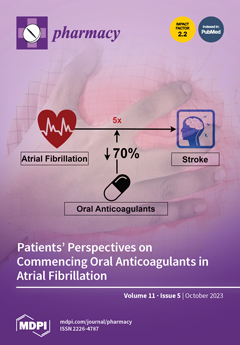Patient access to mindfulness-based stress reduction (MBSR), a complementary and integrative health approach that is proven to reduce chronic pain, can be increased via community pharmacy-based implementation. However, the general public’s awareness and preferences regarding MBSR as a treatment option for chronic pain,
[...] Read more.
Patient access to mindfulness-based stress reduction (MBSR), a complementary and integrative health approach that is proven to reduce chronic pain, can be increased via community pharmacy-based implementation. However, the general public’s awareness and preferences regarding MBSR as a treatment option for chronic pain, including provider roles (pharmacist vs. non-pharmacist), are unclear. Therefore, the purpose of this study was to assess the U.S. general public’s knowledge, attitudes, barriers, and programmatic preferences regarding MBSR for chronic pain management, particularly in the community pharmacy setting. A cross-sectional, anonymous online survey was distributed to U.S. adults ≥18 years via the Amazon Mechanical Turk (MTurk) online survey platform. The survey instrument was informed by Anderson’s framework for health service utilization. Measures were assessed using multiple-choice and 5-point Likert-type scales (1 = strongly disagree, 5 = strongly agree). Primary outcome measures included: (1) knowledge and awareness of MBSR (12-items); (2) confidence in seeking out MBSR for pain (5-items); (3) barriers to receiving MBSR (11-items); (4) beliefs about MBSR in general (12-items); (5) beliefs about community pharmacy-delivered MBSR (15-items); and (6) preferences for MBSR classes/programs (6-items). Outcomes were analyzed using descriptive statistics, and influential factors associated with mean beliefs regarding community pharmacy-delivered MBSR for chronic pain management were assessed via multiple linear regression. Of the 302 survey respondents, the majority were white (79.1%) and female (50.7%), with a mean age of 44.65 years. Respondents’ self-rated MBSR knowledge (mean [SD] scale score: 2.30 [0.68]) and confidence (2.65 [0.87]) were low, although perceived barriers to access were low overall (2.22 [0.53]). Beliefs regarding the use of MBSR for treatment of chronic pain were positive in general (3.67 [0.71]), but more negative regarding community pharmacy-delivered MBSR (2.38 [0.56]). Confidence in seeking out MBSR (β = 0.297, 95% CI = 0.219 to 0.375;
p < 0.001) and current opioid use (β = 0.419, 95% CI = 0.147 to 0.690;
p = 0.003) were positively associated with beliefs regarding pharmacy-delivered MBSR, while annual household income (β = −0.124, 95% CI = −0.244 to −0.004;
p = 0.043) and level of bodily pain (β = −0.149, 95% CI = −0.291 to −0.008;
p = 0.039) exerted statistically significant negative influences. Respondents preferred a hybrid MBSR class format including both online and in-person components (29.7%) as well as both group and individual session options (43.7%). In conclusion, further education is necessary to increase the public’s perception of community pharmacies as a resource for complementary and integrative health.
Full article





